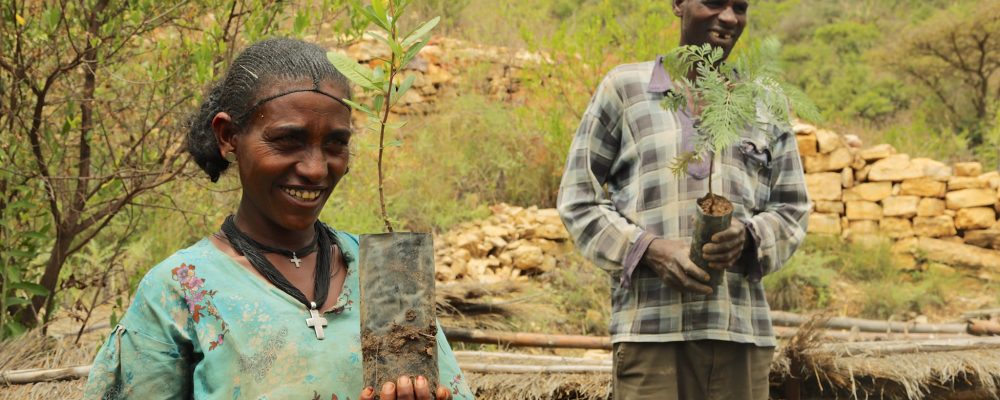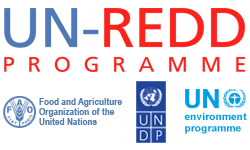
This annual report presents the cumulative results of the UN-REDD Programme up to and including 2021. It builds on, and continues, a progressive series of technical, policy and knowledge achievements at the nexus between climate and forests since the Programme’s launch in 2008.
2021 has been a transition year for the UN-REDD Programme, moving from a phase focused on REDD+ readiness and capacity building to a new phase designed to support massively scaled-up international REDD+ implementation.
Looking to the 2030 horizon, the goal of UN-REDD is to help fully realize the mitigation potential of forest solutions to the climate emergency by avoiding carbon emissions and fostering carbon sequestration at levels of at least 5 GtCO2e per year (as proposed by the 2019 IPCC Special Report on Climate Change and Land and the 2018 UNEP Emissions Gap Report). In pursuing this goal, UN-REDD will employ both proven and innovative approaches to help countries implement sustainable land and forest policies and investments, access climate finance for carbon emission reductions and promote social inclusion in climate policies and finances, while simultaneously realizing non-carbon benefits including safeguarding biodiversity, supporting local livelihoods and advancing the rights of indigenous peoples and local communities (IPLCs).
Within the scope of this ambition, UN-REDD initiated the implementation of its new results framework for the period 2021-2025, aiming to support countries in implementing and enhancing forest solutions to the climate emergency. This results framework positions UN-REDD to assist countries in accessing performance-based finance schemes for REDD+ results, including carbon markets (under Article 6 of the Paris Agreement), by supporting them to meet standards of high environmental integrity and to advance their efforts in delivering results. The results framework is based on more than a decade of UN-REDD experience and lessons learned at the global, country and community levels, as well as on the aims and provisions of the Paris Agreement – this century’s milestone treaty for climate action. It aligns UN-REDD with other major international development undertakings in the coming decade, as the Paris Agreement enters full implementation and as the Sustainable Development Goals (SDGs) are realized.
In 2021, UN-REDD assistance to partner countries completing the four pillars of the Warsaw Framework for REDD+ was largely concluded. This is the foundational requirement for countries to access results-based finance for their REDD+ actions and results. Adopted in 2013, the Warsaw Framework outlines four areas of REDD+ readiness: national REDD+ strategies or action plans (NS/AP), national forest monitoring systems (NFMS), forest reference emissions levels/forest reference levels (FREL/FRL) and safeguards information systems (SIS).
Over the years, UN-REDD has supported more than 30 countries in the global south to elaborate NS/AP, of which 26 have formally endorsed these policies at a ministerial or parliamentary level. UN-REDD has also supported more than 50 countries in developing robust NFMS and 29 countries in submitting FREL/ FRL to the UNFCCC. On the safeguards front, key achievements in 2021 included the launch of SIS in Peru and the development of DRC’s SIS webpage and upgrades to the systems in Mexico and Chile, bringing the number of countries supported by the Programme, with their approaches to meeting UNFCCC safeguards requirements, to 36.
Despite the disruption and delivery challenges caused by the COVID-19 pandemic, many REDD+ countries continued to make significant progress towards REDD+ implementation in 2021 with UN-REDD Programme support. Throughout the year, 16 partner countries and one region – the Lower Mekong – received customized UN-REDD support through national programmes and technical assistance for REDD+ implementation. Country-level work was complemented by knowledge management (KM) and communications support, further extending the reach of the Programme’s support to its many partner countries and beyond. Highlights of support to countries are presented below for each of the four outcomes of the UN-REDD 2021-2025 Results Framework.
OUTCOME 1. FOREST SOLUTIONS REALIZED.
UN-REDD provided comprehensive support on the Warsaw Framework elements, as highlighted above. This support positioned partner countries to advance implementation of REDD+, addressing drivers of deforestation. This included support to advance sustainable management of forests, particularly through community forestry, to manage and enhance fire management preparedness and to address the agricultural drivers of deforestation and restore degraded lands, in close conjunction with efforts of the UN decade on ecosystem restoration. It also included actions to strengthen readiness and enable countries and jurisdictions to anticipate and meet requirements of emerging standards with stricter social and environmental requirement (for example ART-TREES). Specifically, the Programme is expanding support to improve forest monitoring systems, expanding the use of high-resolution imagery, improving their quality of products, expanding reported REDD+ activities, enabling reporting under multiple standards and nesting activities across scales.
OUTCOME 2. FOREST SOLUTIONS REWARDED.
Progress towards achieving the mid-decade target of mobilizing $5 billion for REDD+ from results-based financing was made in 2021 by focusing on support for seven countries including Costa Rica, DRC, Ecuador, Ghana, Papua New Guinea (PNG), Uganda and Viet Nam. This support was in the preparation of LEAF proposals for anticipated future emissions reductions and/or enhanced removals (ERRs) over the 2022-2026 period. One hundred percent of countries requesting technical assistance from UN-REDD on LEAF proposals successfully completed the initial technical screening process. Eighty percent (four out of five) – Costa Rica, Ecuador, Ghana and Viet Nam – are in the first wave of jurisdictions entering purchase agreement discussions and have signed Letters of Intent (LoI) with LEAF Coalition corporate participants. Based on the forecast ERRs in LEAF proposals, the total potential REDD+ results-based financing that could be achieved over the 2022-2026 period in the countries technically assisted by UN-REDD in 2021 is between $1 – 1.2 billion.
OUTCOME 3. FOREST SOLUTIONS ENHANCED.
UN-REDD has been supporting countries in integrating and enhancing Land Use, Land-Use Change and Forestry Sector (LULUCF) actions related to REDD+ to increase the ambition in their new or updated Nationally Determined Contributions (NDCs). This includes support for the inclusion of enhanced or new targets or commitments in the forest sector, as well as for improvements to the institutional coordination for submission of NDCs and for securing finance to enhanced NDC mitigation actions in the forest sector. With UN-REDD support, countries like Chile, Colombia and Côte d’Ivoire integrated enhanced quantitative forest and REDD+ related targets in their NDCs in 2021, in time for the Glasgow climate summit where a first NDC political stocktake took place. Meanwhile, Costa Rica is accelerating the achievement of its forest sector NDC mitigation targets through implementation of the Results-based Payment for REDD+ from the GCF.
OUTCOME 4. CONNECTING ACTORS AND KNOWLEDGE FOR FOREST SOLUTIONS.
To further deliver on Outcomes 1-3 and to serve its large family of partner countries, UN-REDD continued to work on capturing, managing and disseminating knowledge on how to scale up REDD+ implementation to accelerate climate action. This included a virtual regional knowledge exchange where UN-REDD partner countries from Latin America shared lessons learned and good practices from the first pilot phase of Green Climate Fund (GCF) RBPs. In addition, UN-REDD organised and conducted a virtual, trilingual panel at the Global Landscapes Forum Amazonia, a South-South exchange between Costa Rica, Ecuador and Suriname on indigenous rights in forest affairs, and webinars on the Open Tenure tool. Moreover, a total of 10 knowledge briefs were drafted, produced and released, summarising the Programme’s knowledge and good practices on landscape approach and planning, forest tenure, indigenous peoples’ rights, financing and private sector, forest monitoring systems and MRV, linking REDD+, the Paris Agreement, NDCs and the SDGs, REDD+ funding mechanisms, safeguards and gender.
UN-REDD continued to garner collective political and societal support for forest-based solutions through various online activities including: an event on scaling up forest finance at UNFCCC COP26, knowledge generation and dissemination on forest-positive agriculture and halting deforestation, contributing to the 5th session of the UNFCCC Local Communities and Indigenous Peoples Platform, and collaboration with the Asia Indigenous Peoples Pact.
The UN-REDD Programme continued the development and deployment of digital tools to enhance support to partner countries. The Open Foris initiative to support multi-purpose forest inventories, data processing and dissemination of results was further developed and Openforis Arena (a web based platform) was launched in 2021. In support of socially inclusive digital cooperation and virtual engagement, UN-REDD compiled and assessed lessons and approaches for the digital participation of indigenous peoples in policy and institutional processes in Colombia, a pilot initiative to scope best practices for inclusive digital participation of indigenous peoples and rural communities.
In 2021, the UN-REDD Programme continued to support partner countries in advancing their efforts to integrate gender equality and women’s empowerment principles into their REDD+ actions, particularly on REDD+ implementation and RBP efforts. Within this context, the gender approach of the Programme was informed by the findings and results of the 2020 UN-REDD gender survey, which explored and identified ways to further promote the equitable and active participation of women and men in the COVID era of cooperation. Furthermore, the 2018-2020 UN-REDD Gender Marker ratings were analysed, showing that UN-REDD almost achieved its ambitious target of having 50 percent of its 55 outputs receive the highest gender rating.
The Glasgow COP, at the end of the year, shone a spotlight on the contributions of forests to combating climate change and keeping the 1.5oC target alive. The conference yielded a number of milestone commitments and 80 percent of the signatories to the Paris Agreement signed a $12-billion Declaration on Forests and Land Use. 2022presents UN-REDD with a powerful opportunity to advance the forest and climate agenda as we travel the road from Glasgow to Sharm el-Sheikh. The Programme will make concrete progress on building strong partnerships to scale up and connect country ambition and action with massively scaled up finance. Strategic priorities for UN-REDD in 2022 include: convening stakeholders involved in bringing a diverse pipeline of REDD+ results to meet a range of results-based finance opportunities; sustainable, deforestation-free approaches to commodity supply chains; and, support to government-led IPLC processes and platforms. UN-REDD stands ready and equipped to join hands across constituencies to help make the COP26 forest declarations and pledges an unequivocal success.

